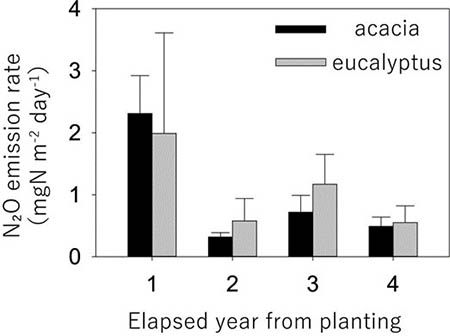Home > Research > Research Results > Research Results 2020 > Merely converting from leguminous acacia to non-leguminous eucalyptus does not reduce N2O emissions in the short term
Update:December 18, 2020
Main content starts here.
Merely converting from leguminous acacia to non-leguminous eucalyptus does not reduce N2O emissions in the short term
| Article title |
Effects of conversion from leguminous acacia to non-leguminous eucalyptus on soil N2O emissions in tropical monoculture plantations |
|---|---|
| Author (affiliation) |
Shigehiro Ishizuka (a), Taiki Mori (b), Yuki Nakayama (c), Chiaki Kawabata (c), Ryota Konda (c), Takuya Sasaki (c), Yukiko Sawa (c), Yuki Hamotani (c), Yukari Gobara (c), Kei Kuwashima (c), Agus Wicaksono (d), Joko Heriyanto (d), Arisman Hardjono (d), Seiichi Ohta (c) (a) Department of Forest Soils, FFPRI, Tsukuba, Ibaraki, Japan. (b) Kyushu Research Center, FFPRI, Kumamoto, Japan. (c) Kyoto University, Kyoto, Japan. (d) PT. Musi Hutan Persada, South Sumatra, Indonesia. |
| Publication Journal |
Forest Ecology and Management, 481, 118702, February 2021 DOI:10.1016/j.foreco.2020.118702( External link ) |
| Content introduction |
Leguminous tree species fix and use atmospheric nitrogen through nitrogen-fixing rhizobia, so there is much nitrogen not only in the tree bodies but also in their leaf litter. Leaf litter that contains large amounts of nitrogen is added to the soil, which increases the amount of nitrogen cycling in the soil. Nitrous oxide (N2O), which accounts for 6% of greenhouse gases but which has about 300 times the greenhouse effect of carbon dioxide, is emitted in large amounts in places having a large nitrogen cycling in the soil, so areas planted with leguminous tree species are thought to be important sources of N2O. Therefore, we investigated whether or not replacing acacia, a leguminous tree, with eucalyptus, a non-leguminous tree, in a forest plantation could suppress the amount of N2O emissions. In areas where a leguminous acacia forest was clear-cut, the emission rate in areas replanted with acacia was 0.96 mg N m-2 day-1, whereas the rate in areas replanted with eucalyptus was 1.07mg N m-2 day-1, showing almost no difference. The reason for this may have been that the high nitrogen cycling rate in the soil, which increased during the time when the acacia forest had been planted, was maintained at a high level even after the area was planted with eucalyptus. Even when the tree species was converted from acacia to eucalyptus, it did not reduce the amount of N2O emissions. Because the results of this study are from a relatively short time of 4 years, it is necessary to derive a conclusion from longer-term observations. Nonetheless, the present results indicate that it is necessary to consider options besides conversion of tree species as a means of reducing N2O emissions.
Photo: Left: acacia plantation. Right: eucalyptus plantation.
Figure: During the period from 1 to 4 years after planting, there was consistently no significant statistical difference between acacia and eucalyptus forests in the N2O emission rates from the soil. |
Copyright © Forest Research and Management Organization. All rights reserved.


